Will Covid-19 change everything or nothing for brands?
Predicting the long term implications of Covid-19 for brands is the hottest topic in marketing today. Most predict radical and permanent changes. “The emergence of a new behavioural group is going to have a transformative impact on the future of brands,” claims a recent Forbes article, for example (1). At the other extreme is Mark Ritson, who suggests that such predictions are “fever dreams driven by the aspirations of the writer.” He argues vehemently that little will change long term. “Evolution that was taking place will continue, perhaps cataylsed slightly … but it won’t be drastically different,” he suggests (2).
So, who should you believe? In this post we will look at this question from three different angles: HOW = behaviours; WHY = needs; VALUE = price/quality. This follows an earlier post here looking at short term responses to the crisis.
HOW people are behaving NOW…
Covid-19 is an unprecedented shock in terms of severity, suddenness, media hysteria, duration and globality. Over 80% of UK people admit that “daily life has been turned upside down” since lockdown started (3). This makes it hard to “study the past to predict the only slightly different but challenging future,” as Mark suggests. For example, the 2008 financial crash was global and severe, but arrived less suddenly and didn’t have the same level of media hysteria; it wasn’t literally a life or death issue.
Another key difference is that for many services, such as eating out and tourism, the ‘tap’ of supply has suddenly been turned off completely. Even during World War 2, supply of goods was rationed, but people could eat out, see friends and family, drink in the pub and go to the cinema. “When war was declared, cinemas were immediately closed as a safety precaution,” observes Screen Online (4). “But most were back in business within a week as the nation needed entertainment to keep up its spirits.”
In response to Covid-19’s seismic shockwaves, buying behaviours have instantly and radically changed in two main ways:
- Extras: buying more of a product or service, without this replacing something else (e.g. home & personal hygiene products, such as cleaning wipes and face masks).
- Switches: swapping one unavailable service for another (e.g. substituting fast food restaurants with take-out delivery – see below examples from London Business School)
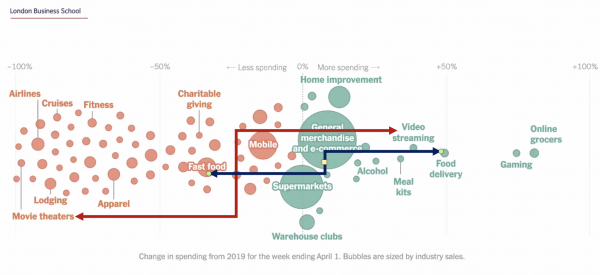
… HOW will people behave POST-CRISIS?
The million dollar question is how consumer behaviours will adjust, or not, once the crisis lessens and lockdowns are gradually lifted. Most commentators predict the changes happening now will be permanent. “Has coronavirus changed retail forever?” asks Retail Connections, in one typical attention-grabbing headline (5). “Consumers will quickly ‘snap back’ to former norms,” is Mark Ritson’s contrarian view (2). So, who is right, Ritson or the rest?
On the one hand, we are creatures of habit. After 9/11, fear forced people to stop flying, even though they were legally allowed to do this. Yet within a year there was a sharp snap-back in demand (see below), encouraged by tightened security measures (6). However, the Covid-19 lockdown has lasted long enough for new habits to form: this takes 66 days on average, according to UCL research (7). In theory, this means that some switches (e.g. switching gym membership for online fitness videos) might persist and not ‘snap back’.
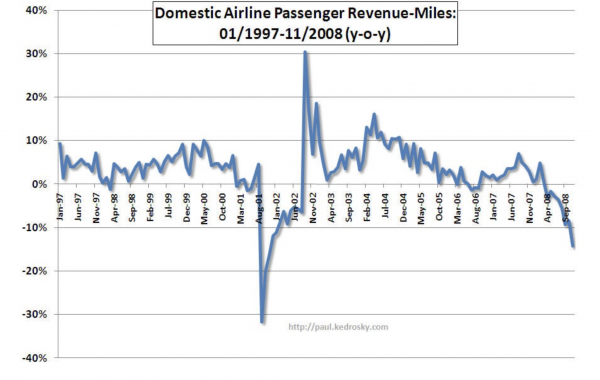
A key factor determining the degree of snap-back not mentioned so far, is consumer satisfaction with these changes, which I suggest will vary by category (see below):
- Lower satisfaction = snap-back MORE likely: we’ve switched restaurants for more take-outs, but I estimate that satisfaction with this switch is low. Once lockdown is lifted, pent up demand will see millions of us ‘snapping back’ and trying to book a table for dinner. The brand challenge here, and in travel, will be complying with social distancing and hygiene requirements, for both legal reasons and to reassure nervous customers, without reducing capacity below profitable levels.
- Higher satisfaction = snap-back LESS likely: people who’ve switched expensive gym subscriptions for online classes might be happy with this switch and not re-new their subscriptions. And our own research shows 62% of people find virtual workshops almost or as good as face-to-face versions. The brand challenge here will be different: how to sell the experiential benefits to persuade people to snap back to previous behaviours?
And the above changes, in contrast to previous crises like the 2008 financial crash, will be unpredictable and unstable, depending on trends in infection levels and the availability of an effective treatment and/or vaccine. This means marketing teams will have to be agile and quick to respond on the hoof.
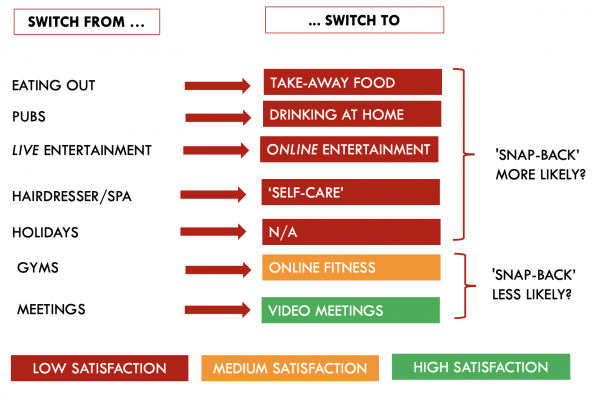
WHY: what people need and want
The second question goes deeper to look at fundamental human needs from brands. And again, we have two polar opposite views, with three dimensions making up most of the debate:
- Personal enjoyment vs. Societal good: “All future brand activity will need to benefit society, and not only the individual,” claims the Forbes article quoted earlier, for example (1).
- Adventure vs. Safety: will holiday makers be emotionally scarred by Covid-19, and prioritise safety over adventure, for example?
- Novelty & newness vs. Trust & familiarity: “Anxious shoppers seek comfort in old favourites,” stated The Times for example (8), reporting sales increases for big brands previously seen as boring and out-dated in the face of attack by smaller ‘insurgent’ brands.
Here, brands need to avoid ‘knee-jerk’ changes and find the right balance of freshness and consistency, based on research into mainstream consumer values in April 2020 compared to July 2018, by Reach Solutions (9). This shows that the importance of different key values is broadly unchanged (see below), although needs for conformity and tradition do look slightly higher, as you might expect.
This suggests that whilst HOW we consume products and services may change significantly, WHY we consume brands is likely to change more slowly. In other words, we will still buy Volvo cars for safety, but also VW Golf GTIs for speed and fun. We will look for the reassuring warmth of familiar foods (e.g. Bisto gravy granules in the UK), but also want the fun flavours of Ben & Jerry’s ice cream.
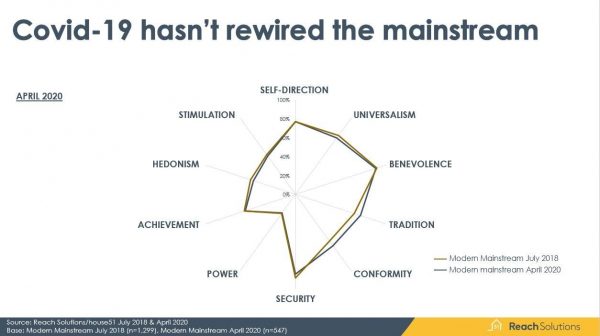
VALUE how people balance price vs. quality
One thing everyone agrees on is that a severe post-Covid recession is coming to a market near you soon, and that all brands needs to prepare for this. Already, 60% of people are being more careful with online spending, versus only 12% spending more online, in a UK study by Mapp.com (10).
This recession may require a fine-tuning of brand positioning, as was the case with work we did with Sainsbury’s after the financial crash in the late 2000’s. The brand idea evolved from being focused on experimentation, “Try something new today”, to more of balance between enjoying life and saving money: “Live Well for Less”. This inspired business building initiatives such as ‘Feed your family for a fiver’ and Brand Match, which gave a coupon on check out if your shopping was more expensive that other supermarkets.

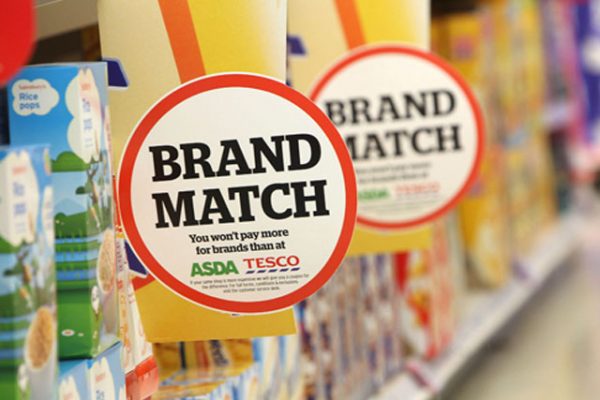
Smart marketers are already working on pricing and promotion strategies to prepare for the recession. “We’ll need to respond from a promotions and pricing point of view to this recessionary environment,” explained Bird’s Eye UK’s general manager Steve Challouma (11). “Is it better to offer more everyday low-prices versus the volatility of deep promotions? That’s something we’ll work on over the next couple of months with retail customers.”
Finally, ‘pack price architecture’ will play an important role to encourage people to stick to their ‘regular’ brands, and not switch to cheaper alternatives. Our Managing Partner in Mexico City, Bety Martinez, has some hard-earned experience here, having managed brands through four economic crises. “One successful strategy is to ensure availability of SKUs at both extremes of the revenue management scale,” she recommends. “Smaller-sized versions for those struggling with cash availability and larger sizes offering good value per unit”.
In conclusion, I suggest ignoring the two extremes of “everything will change” and “nothing will change” for brands. The truth is likely to lie somewhere in between, and will vary depending on whether you are looking at behaviours, needs or value for money, and will also vary depending on your category. Whatever you believe and decide as a result, good luck in coping with these crazy Covid times!
Sources:
- https://www.forbes.com/sites/kianbakhtiari/2020/05/18/how-will-the-pandemic-change-consumer-behavior/#5469e29966f6
- https://www.marketingweek.com/everything-change-forever-after-coronavirus/
- https://www.raisin.co.uk/newsroom/articles/britain-lock-down/
- http://www.screenonline.org.uk/film/cinemas/sect4.html
- https://www.retailconnections.co.uk/articles/the-post-pandemic-shopper-has-coronavirus-changed-retail-forever/
- https://seekingalpha.com/article/120335-domestic-air-travel-lowest-since-postminus-9-11
- https://www.happyfeed.co/research/how-to-form-healthy-habits
- https://www.thetimes.co.uk/article/ahh-bisto-anxious-shoppers-seek-comfort-in-old-favourites-j538m2gwn
- https://www.reachsolutions.co.uk/insights
- https://mapp.com/resources/
- https://www.marketingweek.com/marketers-retain-new-consumers-post-lockdown/


